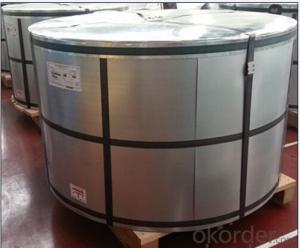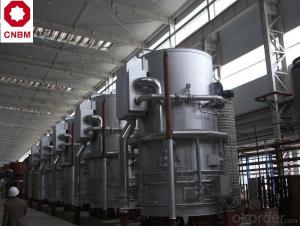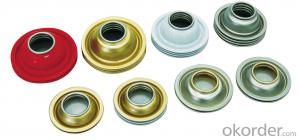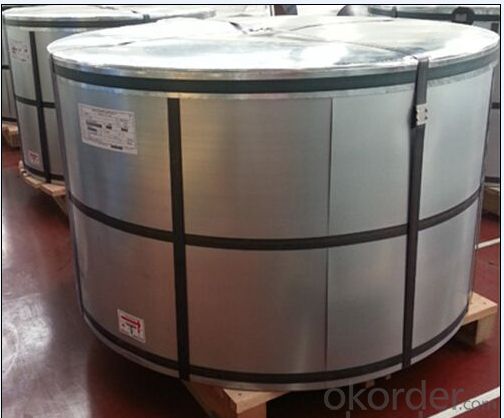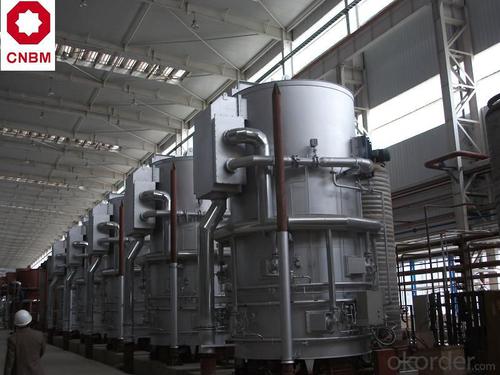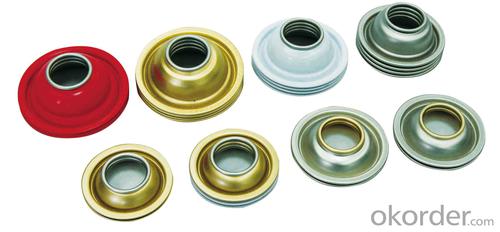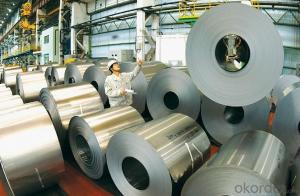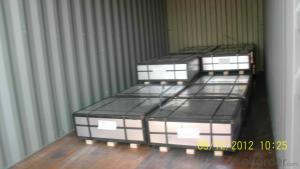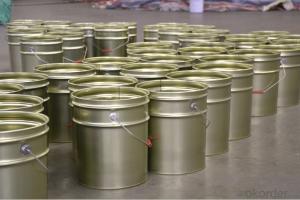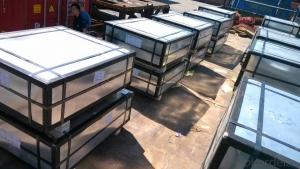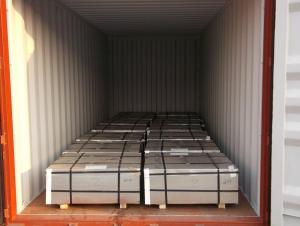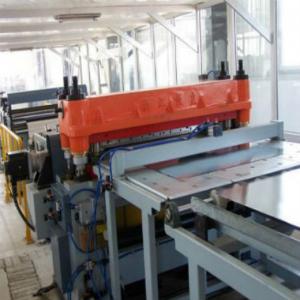Tinplate Manufacture For Biscuits Cans, MR/SPCC Material
- Loading Port:
- China main port
- Payment Terms:
- TT OR LC
- Min Order Qty:
- 25 m.t.
- Supply Capability:
- 40000 m.t./month
OKorder Service Pledge
OKorder Financial Service
You Might Also Like
1.Brief Introduction
Tinplate is widely used for making all types of containers, containing industrial usage such as paint can, oil can, aerosol cans etc., and food cans like milk powder cans, tomato paste can, dry food cans etc.
2. Quality
As a state owned company and a large tinplate supplier in China, our tinplate quality ranks 1st level in China, similar to Bao Steel, Posco etc.
3. Specification
standard: GB/T2520, JIS G3303, DIN EN10202
Material: MR /SPCC
Thickness available: 0.16-0.50MM
Width available: 600~1050MM
Temper grade: T1 – DR8
Tin coating: ordinary 2.8g/2.8g, 5.6g/5.6g and others
Package: sea worthy export package.
Applications: Tin can for chemicals & paint cans, industrial cans, food cans
4. Our production steps
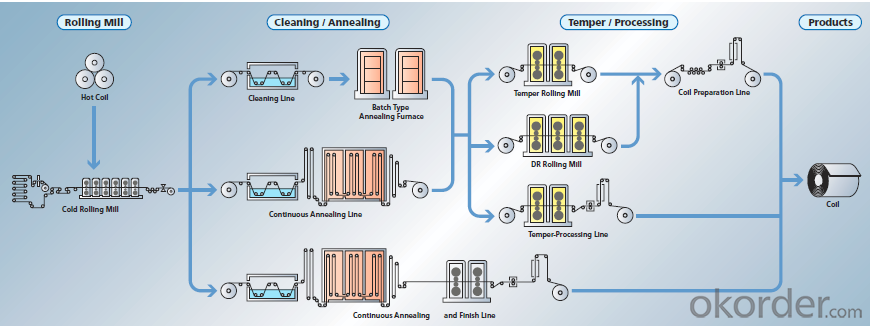
5. Usage Scope
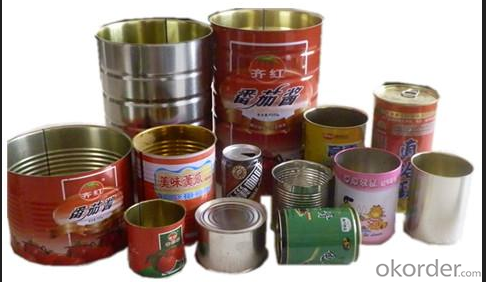
6. Our euxport market
our tinplate has been popularly exported to more than 30 countries, including Asia, Europe countries, Gulf area, Sounth America, Northe & South Africa etc.
7. FAQ
a. what's the annual output?
about 500,000 tons per year.
b. where's the raw matrial from?
our hot rolled coil is purchased from Capital Steel and other state owned mill, with quite good quality.
c. how long is the delivery time?
normally for SPCC about 45~55 days, while 65~75 days for MR material
d. how to control the quality during production process?
inside our workshop, we have MES syestem. It realizes the optimization of the production procedure in the workshop. It could record each step of the whole production procedures, and if some problem appears, factory could easily found and take action, it’s quite helpful to monitor and control the quality.
- Q: How is tinplate coated with protective lacquer?
- Tinplate is coated with protective lacquer by first cleaning and pre-treating the surface to remove any contaminants. Then, a thin layer of lacquer is applied onto the tinplate using various methods such as roller-coating or spray-coating. The lacquer acts as a barrier, protecting the tinplate from corrosion, oxidation, and other external factors that may affect its quality and durability.
- Q: What are the environmental benefits of using tinplate?
- There are several environmental benefits of using tinplate. Firstly, tinplate is highly recyclable, meaning it can be reused multiple times without losing its properties. This helps reduce the demand for new raw materials and decreases the amount of waste sent to landfills. Additionally, tinplate is resistant to corrosion, which means it has a longer lifespan compared to other packaging materials. This reduces the need for frequent replacements, thereby conserving resources and reducing overall environmental impact. Lastly, tinplate has excellent barrier properties, which protect the contents of the packaging from external factors such as moisture, light, and oxygen. This helps preserve the quality and freshness of the products, reducing food waste and promoting sustainability.
- Q: What are the different types of tinplate closures available?
- Some of the different types of tinplate closures available include twist-off caps, lug caps, crown caps, and press-on caps.
- Q: What are the common corrosion protection methods used for tinplate?
- The common corrosion protection methods used for tinplate include electroplating with tin, applying organic coatings such as lacquers or varnishes, and using corrosion inhibitors.
- Q: What are the benefits of using tinplate for electrical components?
- Tinplate offers numerous benefits for electrical components. Firstly, it provides excellent corrosion resistance, ensuring the longevity and durability of the components. Secondly, tinplate has excellent solderability, making it easier to connect and assemble electrical circuits. Additionally, tinplate is a good conductor of electricity, allowing for efficient flow of electrical currents. Lastly, it is a cost-effective option, as tinplate is readily available and relatively inexpensive compared to other materials.
- Q: What are the main technological advancements in tinplate production?
- Some of the main technological advancements in tinplate production include the introduction of automated production lines, advanced coatings for improved corrosion resistance, precision control systems for thickness and flatness, and the use of high-speed cutting and printing machinery. These advancements have significantly increased the efficiency, quality, and versatility of tinplate production, making it a highly advanced and competitive industry.
- Q: What are the common challenges in recycling tinplate packaging?
- Some common challenges in recycling tinplate packaging include the separation of tinplate from other materials, such as plastic or paper, which can be time-consuming and costly. Additionally, the removal of any residual contents or labels from the tinplate can be challenging. The recycling process may also be complicated by the presence of coatings or laminations on the tinplate. Finally, the availability of recycling facilities specifically equipped to handle tinplate packaging can be limited, leading to logistical difficulties in the recycling process.
- Q: Can tinplate packaging be used for home decor products?
- Yes, tinplate packaging can be used for home decor products. Tinplate is a versatile material that can be easily molded into various shapes and sizes, making it suitable for packaging a wide range of home decor items such as candles, vases, small decorative objects, and more. Additionally, tinplate offers a sleek and attractive look, which can enhance the overall aesthetic appeal of the home decor products.
- Q: What are the limitations of using tinplate?
- One limitation of using tinplate is its susceptibility to corrosion. Tinplate can easily rust when exposed to moisture or acidic environments, making it less durable and suitable for long-term use. Additionally, tinplate is relatively heavy compared to other packaging materials, which can increase transportation costs. Lastly, tinplate is not as malleable as other metals, making it less flexible for certain manufacturing processes.
- Q: Can tinplate be used for jewelry and fashion accessories?
- Yes, tinplate can be used for jewelry and fashion accessories. It is a versatile material that can be shaped and designed into various forms, making it suitable for creating unique and intricate jewelry pieces. Tinplate is also durable and lightweight, making it comfortable to wear. Additionally, it can be coated with different finishes or colors to enhance its aesthetic appeal.
Send your message to us
Tinplate Manufacture For Biscuits Cans, MR/SPCC Material
- Loading Port:
- China main port
- Payment Terms:
- TT OR LC
- Min Order Qty:
- 25 m.t.
- Supply Capability:
- 40000 m.t./month
OKorder Service Pledge
OKorder Financial Service
Similar products
Hot products
Hot Searches
Related keywords
